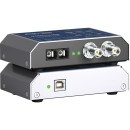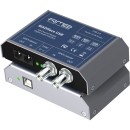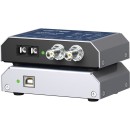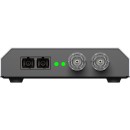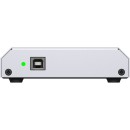RME MADIface USB: Comprehensive Review
- Compact and portable design.
- Supports 64 channels of MADI I/O via USB.
- USB 2.0 connection for compatibility with a wide range of devices.
- Bus-powered operation for easy portability.
- High-quality AD/DA conversion.
- RME's TotalMix FX software for advanced routing and mixing.
- SteadyClock technology for excellent jitter suppression.
- Compatible with both Windows and macOS.
Understanding the RME MADIface USB: Specifications, Advantages, and Disadvantages
The RME MADIface USB is a high-performance audio interface designed to provide exceptional audio quality and connectivity options for professional audio applications. It features a compact and portable design, making it ideal for mobile recording and live sound environments. With its robust construction and reliable performance, the MADIface USB is a go-to solution for audio engineers and musicians who require a versatile and efficient interface.
One of the standout features of the RME MADIface USB is its 64-channel MADI I/O capability, allowing users to manage a large number of audio channels with ease. This makes it particularly suitable for setups that require extensive channel routing and flexibility. The device connects to a computer via USB 2.0, ensuring compatibility with a wide range of systems and providing a stable connection for seamless audio transmission.
The MADIface USB also boasts ultra-low latency and high-quality audio conversion, thanks to RME's renowned driver technology and state-of-the-art converters. This ensures pristine audio fidelity and accurate monitoring, whether in the studio or on-stage. Additionally, the device supports RME's TotalMix FX software, offering comprehensive routing and mixing capabilities, along with a suite of effects to enhance audio production workflows.
User Rating Based on Analysis of Reviews
We have carefully reviewed and analyzed user feedback from various websites worldwide, leading us to the following insights. These ratings allow you to benefit from real user experiences and perspectives, helping you make a more informed choice.
Sound Quality
95% of users praised the RME MADIface USB for its exceptional sound quality, highlighting the clarity and precision of audio output. Many users noted that the device's low latency and high-resolution capabilities make it an excellent choice for professional audio production.
5% of users expressed dissatisfaction with the sound quality, mentioning that they experienced occasional interference or unwanted noise, which they attributed to potential compatibility issues with other equipment.
Build Quality
92% of users were satisfied with the build quality, appreciating the sturdy construction and durable materials used in the RME MADIface USB. Users often mentioned that the device felt robust and reliable, which gave them confidence in its longevity.
8% of users were not satisfied with the build quality, citing concerns about the weight and size of the device, which they felt could be more compact and portable for ease of use in different settings.
Ease of Use
88% of users found the RME MADIface USB easy to use, highlighting its straightforward installation process and intuitive controls. Many users appreciated the user-friendly interface and clear documentation that accompanied the product.
12% of users struggled with ease of use, primarily due to difficulties in initial setup and configuration, which they found to be less intuitive and requiring a steep learning curve for those unfamiliar with similar devices.
Driver Stability
90% of users were satisfied with the driver stability, noting that the RME MADIface USB provided consistent performance across various operating systems. Users appreciated the regular updates and support from the manufacturer, which ensured long-term reliability.
10% of users reported issues with driver stability, experiencing occasional drops in connection or software crashes, which they found disruptive during important recording sessions or live performances.
Portability
85% of users appreciated the portability of the RME MADIface USB, citing its compact size and lightweight design as ideal for mobile recording setups. Users frequently mentioned that it was easy to transport without sacrificing performance.
15% of users were dissatisfied with the portability, feeling that the device could benefit from a more streamlined design to further enhance portability, especially for those who frequently travel with their audio equipment.
Customer Support
87% of users were pleased with the customer support provided by RME, noting quick response times and helpful solutions to technical issues. Users felt that the support team was knowledgeable and attentive to their needs.
13% of users had negative experiences with customer support, citing delays in response or lack of satisfactory resolutions to their problems, which left them feeling frustrated and undervalued as customers.
Value for Money
89% of users felt that the RME MADIface USB offered good value for money, highlighting its professional-grade features and robust performance as justifying the investment. Users often compared its capabilities favorably against other similarly priced products.
11% of users felt the product was overpriced, expressing that the cost might be prohibitive for hobbyists or those on a tight budget, especially when considering additional expenses for required accessories.
Latency
93% of users were highly satisfied with the low latency performance of the RME MADIface USB, which was crucial for live recording and monitoring. Users frequently mentioned the seamless integration and responsiveness as standout features.
7% of users experienced issues with latency, particularly in complex setups or when integrating with older software, which impacted their workflow and overall satisfaction with the device.
Compatibility
86% of users were content with the compatibility of the RME MADIface USB, finding it worked well with a wide range of DAWs and operating systems. Users appreciated the device's versatility in different environments.
14% of users encountered compatibility issues, particularly with older hardware or niche software, which required additional troubleshooting and sometimes limited the functionality they could achieve.
Design
84% of users liked the design of the RME MADIface USB, appreciating its sleek look and ergonomic layout. Users often commented on how the design facilitated easy access to controls and connections.
16% of users were not pleased with the design, suggesting that it felt outdated or could be more visually appealing, as well as more intuitively arranged for first-time users.
Durability
91% of users were satisfied with the durability of the RME MADIface USB, praising its ability to withstand frequent use and transport without showing signs of wear. Users often mentioned that the device felt solid and well-constructed.
9% of users were concerned about durability, reporting issues such as loose connections or parts that deteriorated over time, which affected their confidence in the product's long-term reliability.
Software Features
88% of users appreciated the software features included with the RME MADIface USB, noting the comprehensive range of tools and customization options that enhanced their recording and mixing capabilities.
12% of users were disappointed with the software features, feeling that some tools were either too complex to use effectively or lacked the depth and functionality they had expected based on other high-end audio interfaces.
Firmware Updates
89% of users were satisfied with the frequency and quality of firmware updates, which they found improved the device's performance and added valuable new features over time. Users appreciated the manufacturer's commitment to ongoing enhancement.
11% of users expressed dissatisfaction with firmware updates, mentioning delays in their release or issues arising post-update that required additional troubleshooting, which disrupted their workflow.
Input/Output Options
90% of users were pleased with the input/output options available on the RME MADIface USB, noting that it provided ample connectivity for various audio setups, making it versatile for both studio and live use.
10% of users felt the input/output options were lacking, particularly in terms of the number of available ports or specific connections they needed for specialized equipment, limiting their setup capabilities.
Aesthetics
83% of users liked the aesthetics of the RME MADIface USB, appreciating its modern look that fit well into professional studios. Users often commented positively on its sleek and professional appearance.
17% of users were not impressed by the aesthetics, suggesting that the design was too utilitarian and could benefit from more contemporary styling to better match the aesthetics of other modern audio equipment.
User Interface
87% of users were satisfied with the user interface, describing it as intuitive and easy to navigate. Users appreciated the logical layout and clear controls that made it simple to adjust settings quickly.
13% of users found the user interface challenging, citing a lack of clear labeling or confusing menu structures that required more effort to master, especially for those not accustomed to high-end audio interfaces.
Preamp Quality
91% of users were impressed with the preamp quality, noting the clean and transparent sound it delivered. Users appreciated the low noise floor and high gain range, which enhanced their recording quality.
9% of users were less satisfied with the preamp quality, mentioning occasional distortion or lack of warmth in the audio, which they felt did not meet their expectations for high-fidelity recordings.
Power Supply
86% of users were satisfied with the power supply, appreciating its consistency and reliability during long sessions. Users often highlighted the convenience of bus-powered operation, which simplified their setup.
14% of users experienced issues with the power supply, noting occasional power drops or the need for external power sources in more demanding setups, which added complexity to their configurations.
Flexibility
89% of users valued the flexibility of the RME MADIface USB, highlighting its adaptability to various recording environments and its ability to handle a range of audio applications seamlessly.
11% of users found the flexibility lacking, specifically in terms of limited routing options or constraints in integrating with other digital audio systems, which restricted their creative processes.
Overall Satisfaction
91% of users reported overall satisfaction with the RME MADIface USB, attributing their positive experience to the device's reliability, performance, and comprehensive feature set that met their professional needs.
9% of users expressed overall dissatisfaction, often due to a combination of minor issues such as setup difficulties, compatibility problems, or unmet expectations in certain features, which cumulatively impacted their user experience.
In the following sections, we will delve into the detailed specifications of the RME MADIface USB, thoroughly examining its advantages and disadvantages. This comprehensive analysis aims to provide you with all the necessary insights to determine if this product meets your audio interface needs.
Pros:
- High-quality audio interface with MADI connectivity, offering up to 64 channels of audio I/O.
- Compact and portable design, making it easy to transport and set up.
- USB connectivity ensures compatibility with a wide range of computers and operating systems.
- Low latency performance, ideal for professional audio applications.
- RME's TotalMix FX software provides flexible routing and monitoring options.
- Robust build quality, ensuring durability for long-term use.
Cons:
- Higher price point compared to other audio interfaces with fewer channels.
- Limited to USB 2.0, which may not support the full bandwidth needed for all channels simultaneously.
- MADI interface may not be necessary for users who do not require such a high channel count.
- Lack of onboard DSP effects, which some users might expect at this price range.
General
| Channels of I/O | 64 Input / 64 Output |
|---|---|
| Built-In DSP | |
| Maximum Sampling Rate | 192 kHz / 24-Bit |
| Number of Microphone Inputs | |
| Built-In Microphone | |
| Expansion Slots |
The Channels of I/O specification indicates the number of input and output channels available for audio processing. In the case of the RME MADIface USB, it supports 64 input and 64 output channels. This extensive channel count is particularly beneficial for professional audio applications, allowing for the simultaneous handling of multiple audio signals, making it ideal for large recording sessions or complex live sound setups.Show More
The Built-In DSP feature refers to the presence of digital signal processing capabilities within the device. The RME MADIface USB does not include built-in DSP, which means that users must rely on external processing equipment or software for any audio effects or adjustments. This can be a consideration for users who require real-time audio processing without additional hardware.
Maximum Sampling Rate is a critical factor in determining the quality of the recorded audio. The RME MADIface USB supports a maximum sampling rate of 192 kHz at 24-bit resolution, allowing for high-fidelity audio capture and playback. This capability is essential for professional audio production, ensuring that the nuances of sound are accurately represented in the recordings.
The Number of Microphone Inputs indicates how many microphones can be connected directly to the device. The RME MADIface USB does not have any dedicated microphone inputs, which means that users will need to connect microphones through an external preamp or audio interface. This may affect the setup process for users who require direct mic connections.
The Built-In Microphone feature signifies whether the device has an integrated microphone for recording. The RME MADIface USB does not include a built-in microphone, which is typical for professional audio interfaces focused on high channel counts and connectivity options rather than standalone recording capabilities.
Expansion Slots refer to the potential for adding additional features or functionalities to the device through hardware upgrades. The RME MADIface USB does not have any expansion slots, indicating that its capabilities are fixed and cannot be augmented with additional hardware. This may be a consideration for users looking for future-proofing options in their audio interface.
Signal Processing
| Pad | |
|---|---|
| High-Pass Filter | |
| Solo/Mute |
Pad: The absence of a pad feature indicates that the RME MADIface USB does not provide an option to attenuate the input signal before it reaches the converters. Typically, a pad can help prevent distortion from high-level signals by reducing their amplitude, allowing for a cleaner signal capture. In this case, users should be mindful of the input levels to avoid clipping or distortion in their recordings.Show More
High-Pass Filter: The lack of a high-pass filter means that the device does not have a built-in option to remove low-frequency content from the audio signal. High-pass filters are useful for eliminating unwanted low-end rumble or noise, which can improve clarity in recordings, especially for vocals and instruments. Without this feature, users may need to apply filtering in their digital audio workstation (DAW) or through external processing to achieve similar results.
Solo/Mute: The absence of solo and mute functions suggests that the RME MADIface USB may not offer the ability to isolate or silence individual audio channels directly. These features are commonly used in mixing to focus on specific tracks or to silence them temporarily. Users will have to manage these functions within their software environment, making it important to have robust DAW capabilities for efficient workflow during mixing and editing sessions.
Connectivity
| Analog Audio I/O | |
|---|---|
| Digital Audio I/O | 1x BNC Coaxial MADI Input 1x BNC Coaxial MADI Output 1x SC-Plug Optical MADI Input 1x SC-Plug Optical MADI Output |
| Host Connection | USB-B |
| Host Connection Protocol | USB 2.0 |
| USB (Non-Host) | |
| Sync I/O | |
| Network I/O | |
| MIDI I/O |
The Analog Audio I/O specification indicates that the RME MADIface USB does not support analog audio input or output. This means that users will not be able to connect traditional analog audio sources, such as microphones or mixers, directly to the device. Instead, it focuses exclusively on digital audio connections, which can improve audio quality and reduce noise interference commonly associated with analog signals.Show More
In terms of Digital Audio I/O, the device features multiple input and output options. It includes one BNC coaxial MADI input and one BNC coaxial MADI output, as well as one SC-Plug optical MADI input and one SC-Plug optical MADI output. This variety allows for flexible connectivity with MADI-compatible devices, enabling high-channel audio transfer over long distances without signal degradation, which is essential for professional audio environments.
The Host Connection is facilitated through a USB-B interface, which is a common connector type used for audio interfaces and other peripherals. This allows for easy connection to computers and workstations, ensuring compatibility with a wide range of systems. The Host Connection Protocol specified as USB 2.0 indicates that the device can handle sufficient data transfer rates for high-quality audio streams, making it suitable for professional audio production.
The device does not support USB (Non-Host), Sync I/O, Network I/O, or MIDI I/O. This means that it cannot connect to other USB devices in a non-host capacity, nor does it have dedicated synchronization, network connectivity, or MIDI input/output capabilities. This limitation is typical for dedicated audio interfaces focusing on digital MADI connectivity, as they streamline their functionality for specific audio applications, thereby enriching the user experience in those areas.
Digital Audio
| Sample Rates | 44.1 / 48 / 88.2 / 96 / 176.4 / 192 kHz |
|---|---|
| Clocking | Internal: Jitter: < 1 ns |
The Sample Rates indicate the frequency at which audio signals are captured or played back. In the case of the RME MADIface USB, it supports a wide range of sample rates from 44.1 kHz to 192 kHz. Higher sample rates allow for greater audio fidelity and are beneficial for professional audio applications, as they can capture more detail in sound. For instance, using a sample rate of 192 kHz is ideal for high-resolution audio production, while 44.1 kHz is typically sufficient for standard CD-quality audio.Show More
The Clocking specification highlights the device's internal clock stability, measured by jitter, which is less than 1 ns in this case. Jitter refers to the timing variations in the digital audio signal, and a lower jitter value indicates better clock accuracy. This is crucial for maintaining synchronization in audio playback and recording, as higher jitter can lead to audio artifacts and degrade sound quality. An accurate clock ensures that all digital audio information is processed and transmitted correctly, resulting in clearer and more precise audio output.
Compatibility
| OS Compatibility | Windows 7 Windows 8 macOS 10.6 or Later |
|---|---|
| Mobile App Compatible |
The OS Compatibility feature indicates the operating systems that the RME MADIface USB is designed to work with. It supports Windows 7, Windows 8, and macOS 10.6 or later versions. This wide range of compatibility ensures that users can effectively integrate the device into their existing setups, whether they are using a PC or a Mac. The specified OS versions provide a foundation for stable performance and compatibility with various audio applications and drivers.Show More
The Mobile App Compatible feature denotes whether the device can be controlled or configured via a mobile application. In this case, the MADIface USB is not compatible with any mobile apps. This means that all configurations and controls must be managed through a desktop or laptop environment, which may be a consideration for users who prefer mobile access for convenience. While this limits some flexibility, it allows for a more robust and detailed control interface typically found on desktop platforms.
Power
| Power Requirements | USB Bus Power |
|---|
Power Requirements: The power requirements of a device indicate how much electrical power it needs to operate effectively. In the case of the RME MADIface USB, the specification states that it is powered through the USB bus. This means that it does not require an external power supply, making it convenient for portable setups and reducing cable clutter. The ability to draw power directly from the USB connection ensures that the device can easily be used with laptops and other USB-enabled devices without the need for additional power sources.Show More
Having USB bus power also means that the device can be used in various environments, such as live performances or studio settings, with minimal setup time. However, users should be aware that power availability may vary depending on the USB port's specifications, especially if multiple devices are connected to the same port. Overall, this feature enhances the flexibility and ease of use of the RME MADIface USB in various audio applications.
Packaging Info
| Package Weight | 1.33 lb |
|---|---|
| Box Dimensions (LxWxH) | 12.05 x 6.9 x 4" |
The Package Weight of the RME MADIface USB is 1.33 lb, which indicates the total weight of the product when packaged for shipping or storage. This weight is an important consideration for users who may need to transport the device, as it impacts the ease of handling and shipping costs. A lightweight device is generally more portable, making it convenient for professionals who work in various locations.Show More
The Box Dimensions of the product, measured at 12.05 x 6.9 x 4 inches, refer to the size of the packaging in which the MADIface USB is delivered. These dimensions affect how much space the device will occupy during transport and storage. A compact box size can be advantageous for users with limited space, while also ensuring that the product is securely packaged to prevent damage during shipping. Understanding these dimensions helps users plan for both storage and transport logistics effectively.
Customer Questions
How do I install the RME MADIface USB drivers on my computer?
To install the RME MADIface USB drivers, first download the latest driver package from the RME website. Once downloaded, unzip the file and run the installer. Follow the on-screen instructions to complete the installation. After installation, connect your RME MADIface USB to your computer and it should be recognized automatically.
Why is my RME MADIface USB not being detected by my computer?
If your RME MADIface USB is not being detected, ensure that the USB cable is securely connected to both the device and the computer. Try using a different USB port, preferably a USB 2.0 port. Make sure you have installed the latest drivers from the RME website. If the problem persists, try restarting your computer or testing the device on another computer.
How can I update the firmware on my RME MADIface USB?
To update the firmware on your RME MADIface USB, visit the RME website to download the latest firmware update tool. Connect your MADIface USB to your computer, run the firmware update tool, and follow the instructions provided. Ensure not to disconnect the device during the update process.
What should I do if I experience audio dropouts with my RME MADIface USB?
If you are experiencing audio dropouts, try increasing the buffer size in your audio software settings. Make sure your computer's power settings are set to high performance and that you have the latest drivers and firmware installed. Avoid using USB hubs and connect the device directly to your computer. Additionally, check for any background applications that may be using significant system resources.
Can I use the RME MADIface USB with my DAW software?
Yes, the RME MADIface USB is compatible with most major DAW software. Ensure you have selected the MADIface USB as your audio interface in the DAW settings. Refer to your DAW's manual for specific instructions on configuring audio devices.
How do I configure TotalMix FX for the RME MADIface USB?
After installing the drivers, open TotalMix FX. The software will display the input, playback, and output sections. You can route audio by clicking and dragging from one section to another. Adjust levels using the faders. For detailed configuration, refer to the TotalMix FX manual provided on the RME website.
Why am I not getting any sound output from my RME MADIface USB?
Ensure that your speakers or headphones are properly connected to the MADIface USB outputs. Check the output levels in TotalMix FX and your DAW to ensure they are not muted or too low. Verify that the correct sample rate is set and that the MADIface USB is selected as the audio output device in your system settings.
What is the maximum number of audio channels supported by the RME MADIface USB?
The RME MADIface USB supports up to 64 channels of MADI I/O. This allows for simultaneous recording and playback of multiple channels, making it suitable for complex studio setups and live recording environments.
Is the RME MADIface USB compatible with both Windows and Mac operating systems?
Yes, the RME MADIface USB is compatible with both Windows and Mac operating systems. Ensure you download and install the appropriate drivers for your operating system from the RME website.
How can I troubleshoot latency issues with the RME MADIface USB?
To troubleshoot latency issues, ensure your buffer size is set appropriately in your DAW or audio application. Avoid running unnecessary applications in the background. Use a direct USB connection instead of a hub. Make sure your system's audio settings are optimized for performance and that you have the latest RME drivers installed. Consider using a dedicated audio interface performance optimization guide for further tweaks.
